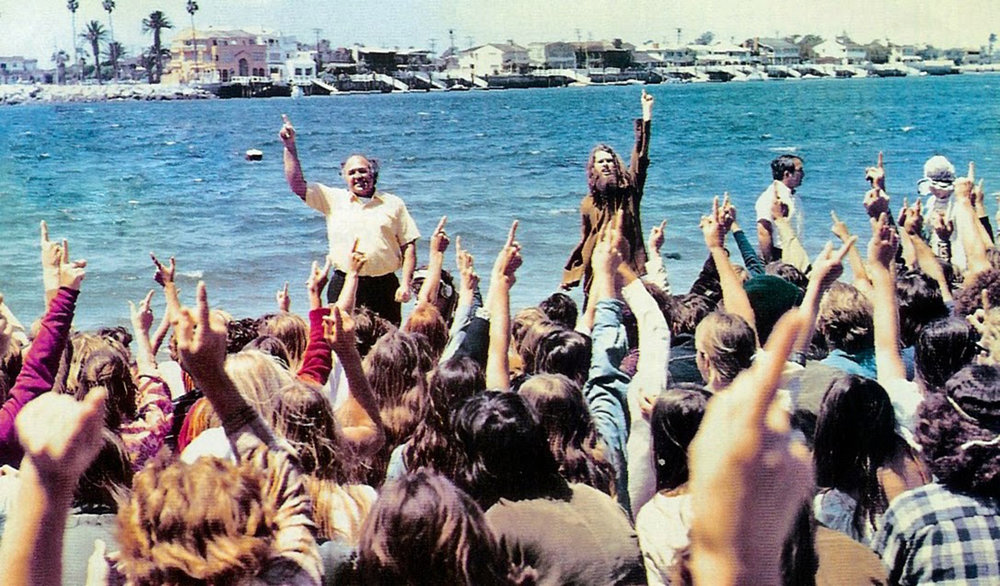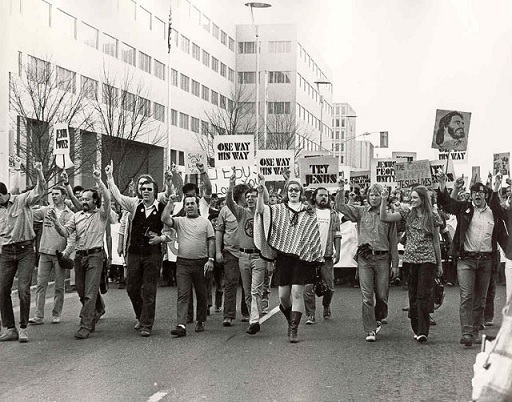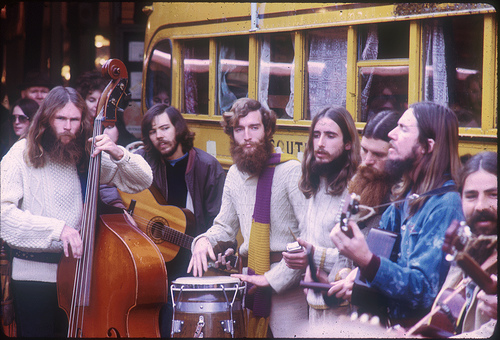In the late 1960s, amid the so-called “Hippie” counterculture movement taking place in the US, a charismatic minister named Duane Pederson came onto the scene. He preached Christianity to the generation known for promiscuous sex, mind-expanding drugs, and pulsating Rock music.
A self-described “Jesus Freak,” Pederson drew comparisons between the Hippies’ message of peace and love with what Jesus is said to have preached. His goal was to enlist them into his “Jesus Army.”
By the early 1970s, Pederson amassed what some describe as a cult-like following estimated at 30,000. They were all professed members of the “Jesus People Movement.”
Although the movement itself was relatively short-lived, it spawned many trends in music, art, spirituality, communal living, and nontraditional church settings that endure to this day.

Arriving on the Scene
Apart from being born in Hastings, Minnesota, and having four siblings (Janice, Marijean, Kay, and William), little is known about Pederson before arriving in California. He arrived sometime in the mid-60s to pursue an entertainment career. By one account, as a ventriloquist.
But rather than follow a path in show-biz as planned, Pederson was drawn to the Hippie counterculture scene erupting in the Haight-Ashbury District of San Francisco. To Pederson, it seemed the perfect setting to introduce Jesus Christ.
The Hollywood Free Paper
In 1969, Pederson launched the Hollywood Free Paper. This was meant to serve as a Christian reaction to the Oracle and other underground countercultural newspapers of the Haight-Ashbury District.
Within two years, circulation of this biweekly “Jesus” publication reached 1,000,000 copies. Each copy was hand-delivered through the streets and across the beaches.
Pederson’s approach to reaching the Hippies was to neither counteract nor denigrate their lifestyle. Instead, he promoted the idea that peace, love, and free-thinking were very much in keeping with Jesus’ teachings.
Pederson was not the first to promote Christianity to the California Hippie community. Seminary student Kent Philpott and Pastor Chuck Smith preceded him. But he was the first to capture their hearts, minds, and imaginations.
Origins of the “Jesus People Movement”
According to most accounts, the “Jesus People Movement” began in 1967. It started with the opening of a small storefront evangelical mission. This was created by Ted Wise who was a drug-using sailmaker-turned-evangelist. He called this storefront the “Living Room.”
It was located in San Francisco’s Haight-Ashbury district–but quickly spread to Los Angeles and Seattle. Most historians consider the opening of the mission (and others) a direct reaction to the “Summer of Love” sex and drug-fest that took place the year before.
Though Christian-based organizations had existed in the area before this, this was the first outreach mission run solely by street people, for street people.
Hippie philosophy embraced a decidedly spiritual dimension (a conglomeration of Eastern meditation, the occult, Native American spirituality, Zen Buddhism, and “Hare Krishna” Hinduism). But, Wise and evangelical pastor John MacDonald believed that the rampant rise in decadence among the youth indicated that they’d strayed from the teachings of Jesus Christ.
Essential to the popularity of the “Living Room” was a charismatic Hippie convert named Lonnie Frisbee, chosen by Wise to be the “face” of the mission.
Soon after, other conservative pastors recruited “Hippie” spokespeople to spread the word of God on their behalf. The “Living Room” dissolved after only eighteen months.
Blessitt, Meissner, Bright, and Sparks
A short time later a street evangelist named Arthur Blessitt, the so-called “Minister of Sunset Strip” entered. He famously preached to members of the Hell’s Angels.
He opened a coffeehouse/counseling center on Sunset Strip in West Hollywood called, “His Place.” This was a 24-hour “walk-in” for young people (located next door to a topless Go-Go club).
Meanwhile in Seattle, the “Jesus People Army” (JPA) came about. It was born of a vision experienced by evangelist Linda Meissner (famous for her book, The Cross and The Switchblade). She claimed she’d seen an “army of teenagers marching for Jesus.”
Meissner, who’d previously ministered to New York City street gangs, opened several other outreach centers throughout the Pacific Northwest before dissolving the JPA and moving to England.
In the fall of 1967, attention shifted from the multitude of wayward kids roaming Bay area streets to the college students at the University of California.
California Campus Crusade for Christ (CCC) president Bill Bright devised what he thought was a workable strategy to attract students at Berkeley to Christianity. At that time, the campus was a boiling cauldron of radicalism, protests, and anti-war marches. But his attempts failed miserably.
In February of 1969, Jack Sparks, a former associate professor of statistics at Penn State (and CCC staff member) visited Berkeley. He decided to relocate there and adopt the same aggressive methods used by the counterculture.
He distributed leaflets, carried signs, hung posters, and used bullhorns during rallies to reach the students. By April, Sparks had successfully established an outreach program called the “Christian Liberation World Front” (CWLF). Its mission was to convert campus radicals to Christianity.

Fundamentals of the “Jesus People Movement”
At the heart of the “Jesus People Movement” was the rejection of intellectualism and the conservative social values of the previous generation. This included the norms of institutional religion.
The “Movement” (as it was most commonly referred to) lacked organization and a universal agenda. This resulted in many disjointed subgroups. Participants nonetheless shared many common characteristics.
Most apparent was their intense evangelistic zeal for the word of Jesus and emphasis on personal experience over Biblical dogma. One of their most distinguishing features was the copy of Good News for Modern Man (the simplified version of the New Testament published in 1966) many carried, quoted, and distributed.
Recognizing that their power lay in numbers, evangelical ministers (like Duane Pederson) organized mass rallies that hundreds–even thousands–of “Jesus Freaks” would attend.
Media Attention
Into the 1970s, Pederson continued to provide spiritual guidance and support to the “Jesus People Movement” in California and Europe. His highly successful publication, the Hollywood Free Paper, was now spreading across much of the world.
Attempting to capitalize on the Free Paper’s effectiveness, “Jesus” papers became a fundamental component of several other street Christian groups. Among them: Right On!, The Fish, Street Level, and Cornerstone–none of which came close to reaching the same status.
The Free Paper became so popular that on multiple occasions between 1970 and 1972 it drew the interest of several mainstream periodicals. These included Time, Life, Newsweek, Look, and Rolling Stone—all of which suddenly found long-haired, bell-bottomed “Street Christians” and “Jesus Freaks” newsworthy.
Life magazine covered the “Jesus Freak” phenomenon in an article called, “The Groovy Christians.” After that, a flood of articles, editorials, television exposes, and even films spotlighting the “Movement” followed.
Suddenly, outdoor prayer gatherings, ocean-side baptismal services, and long-haired street-corner evangelists became fodder for magazines all around the globe.
Coffee Houses, Halfway Houses, and Communes
Around 1970, dozens of new coffee houses sprang up around the San Francisco Bay area and the country.
Simultaneously, halfway houses and new communes were established where members of the “Movement” could live with other like-minded youth. (Communes were far from a new concept; as many as 2000 existed across America in the 1960s.)
While coffee houses had been common meeting places for the Beat Generation in the 1950s, many of those evolved into establishments where Hippies and “Jesus People” could gather. They largely replaced the walk-in missions of a few years before.
Among the more popular were “The Coffee Gallery,” “The Cellar,” and “The Anxious Asp”–added to them, “The Belly of the Whale” and “The Upper Room.”
Between 1969 and the early 1970s, hundreds of independent communes, “halfway houses” (apartment buildings or boarding houses where Hippies could crash for a night or three), and coffee houses/fellowship centers sprang up in southern California. They appeared as far north as Washington State. The “Jesus People Movement” was growing at an extraordinary rate.
The “Lighthouse” and “Shiloh Youth Revival Center”
In 1970, pastor and real estate agent Jim Durken acquired an abandoned coast guard station 11 miles outside Eureka, California. He named it the Jim Durken Lighthouse Ranch (The “Lighthouse”), which he invited young Christians to consider their home.
By 1972, the group had grown to between 250 and 300 active members. With Durkin’s guidance, he began sending out church-establishing teams. Eventually, they founded the organization, “Gospel Outreach” (which today has missions all over the world).
Meanwhile, a small commune called The Shiloh Youth Revival Center was established in the fall of 1968 in Costa Mesa, California by John Higgins. He was a former drug addict who’d converted to fundamentalist Christianity.
This commune relocated to Dexter, Oregon in 1970, effectively becoming the headquarters of the “Jesus People Movement.” “Shiloh” continued to thrive until the mid-1970s–but then began to wane.
In 1978, the Shiloh Board of Advisors dismissed Higgins for his overly-authoritarian leadership style. By 1986 the commune was completely abandoned.
The Advent of “Jesus” Music
To the growing multitude of Street Christians, it seemed like a marriage made in heaven: Rock music and Christianity. One of the first to explore this idea was Barry McGuire. He was a singer/songwriter already known to the Hippie community for his 1965 hit, “Eve of Destruction.”
He became a Born-Again Christian in 1970 (after an encounter with evangelist Arthur Blessitt). McGuire signed with the American Christian music label Myrrh, and released the album Seeds; which failed to produce a hit.
Meanwhile, Phil Keaggy, Paul Clark, Randall Stonehill, Larry Norman, and singer-songwriter Norman Greenbaum (“Spirit in the Sky”) were getting airplay (albeit limited) from select Rock stations across the US. But then a new genre of music emerged: the Rock Opera. And suddenly, “Jesus” music was mainstream.
In November of 1969, the title track to an as-yet-unfinished Rock Opera, Jesus Christ Superstar hit the airwaves. Sung by British actor and singer Murray Head, “Superstar” gives voice to the spirit of Judas Iscariot—the Apostle said to have betrayed Jesus.
During the track, he asks poignant, rhetorical questions of Jesus regarding his bigger plan. Although the song received only limited attention, it was played on mainstream Rock stations. It elevated Christian music to a new level and broader audience.
In October of 1970, “Jesus” music took a giant step forward with the release of Jesus Christ Superstar. It was a Tim Rice-Andrew Webber double Rock album musical dramatization of the last week of the life of Jesus Christ.
It began with his arrival in Jerusalem and ends with his Crucifixion (based primarily on the Synoptic Gospels and Catholic Bishop Sheen’s book, Life of Christ).
Unlike earlier folksy approaches to popularizing “Jesus” music, Rice and Webber enlisted a host of renowned hard Rock musicians. This included Deep Purple vocalist Ian Gillan and members of Joe Cocker’s Mad Dogs and Englishmen band.
Then in 1971, the album was adapted to a full-stage production. Both the album and stage performance proved extraordinarily popular with Christians and non-Christians alike.
Since then, Christian music has evolved into a billion-dollar industry, represented by every genre of music: from Heavy Metal to Country, Blues to Pop, Electronic to Soul, and Rap to New Age.

Pederson’s Monthly Rock Concerts
Recognizing the uniting power of Christian-Rock music, in the early 1970s, Duane Pederson began sponsoring monthly 4-5-hour concerts at the Hollywood Palladium. This included the 1972 “Jesus People Live Festival of Music.”
It featured performances by Dove Sounds, Gentle Persuasion, Harvest Flight, J.C. Power Outlet, Morning Star, and Wedgewood (which was recorded and released as an LP). Every concert attracted thousands of “Jesus Freaks” who attended for the music, fellowship, and ultimately, exaltation of Jesus Christ.
Meanwhile, mainstream media increasingly viewed Pederson as just another charismatic religious radical–with a zealous cult following.
Duane Pederson and the Priesthood
By 1977, an estimated 2 million Born-Again Christians joined the faith. Many were inspired by the “Jesus People Movement.”
In 1978, however, Pederson did the unexpected: He shifted his ministry from Street Youth to prison inmates. He joined Christian Prison Volunteers as a “visiting” minister to the incarcerated and those adjusting to post-parole life on the outside.
Ceasing publication of the Hollywood Free Paper, for the next two years the periodical functioned as a ministry to prisoners called, the Visit.
Now focused exclusively on bringing Jesus to prison inmates, Pederson’s Street Youth disintegrated. Some delved deeper into Christianity, others abandoned it completely.
In 1991, Pederson joined the Antiochian Orthodox Church and was subsequently ordained as a priest.
In 1993 he was tasked by his bishop with creating a national prison ministry. He successfully created this and it ran for more than a decade. In 2005, this ministry was sanctified and named the “Orthodox Christian Prison Ministry” (OCPM)–and carries his reputation.
In 1999, Father Duane Pederson was elevated to the rank of Archimandrite, a title of respect for his many years of service to the Antiochian Orthodox Church. In 2012, “Father Duane” (as he came to be known) was given the “Matthew 25:36 Award” for his lifetime of achievement in prison ministry.
In 2014, Pederson wrote, Larger Than Ourselves: The Early Beginnings of the Jesus People. In this, he recounts how the “Jesus People Movement” began. He includes photos of key individuals and places pertinent to the early years of the “Movement.”
Archimandrite Duane Pederson died on July 20, 2022, at the age of 83.
Today he is remembered more for his prison ministry than his years as a self-described “Jesus Freak.”
References
shilohworshipmusic.com., “The Jesus Movement of the 70s,” The Jesus Movement of the 70s (shilohworshipmusic.com)
Place.asburyseminaryiedu., “The Spontaneous Generation: Lessons from the Jesus Movement
for Today,” https://place.asburyseminary.edu/cgi/viewcontent.cgi?article=1133&context=jascg
Scholarworks.wm.edu., “The Jesus People Movement and the Awakening of the Late
1960s,” https://scholarworks.wm.edu/cgi/viewcontent.cgi?article=5452&context=etd
Pederson, Duane, accessed via: Archive.org., “Jesus People,” Jesus people : Pederson, Duane : Free Download, Borrow, and Streaming : Internet Archive
Angelcraft, JC, Rollingstone, YouTube.com., “The Hollywood Free Paper was issued from 1969-1978,” https://www.youtube.com/watch?v=llJNUr1w6M0
romans.1015.com., “1967-1972 The Jesus Movement,” https://romans1015.com/jesus-movement/
TheConversation.com., “’Jesus People’–a movement born from the ‘Summer of Love’,” ‘Jesus People’ – a movement born from the ‘Summer of Love’ (theconversation.com)

